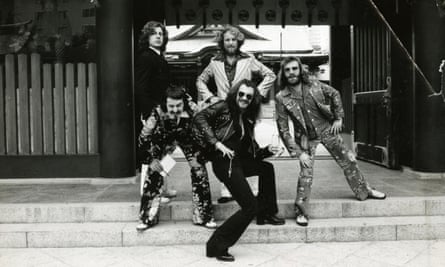When I last interviewed Ian Anderson, leader of multimillion-selling prog rockers Jethro Tull, in 1993, he told me that 2000 would be a good time to hang up his flute. “I think I was confusing myself with British Airways pilots who, when they turn 65, are out,” he counters today. “If you’re a professional tennis player and fully vaccinated, you might manage to play on until you’re in your late 30s. But those of us in arts and entertainment get to die with our boots on, like John Wayne in a black-and-white western.”
Appraising Anderson’s face on my laptop screen, I could easily knock a decade off his 74 years, but it’s still hard to reconcile this loquacious, informed analyser of politics and history with the wild hippy dervish he was circa 1970, famous for playing his flute on one leg. His troll-like hair vanished long ago, but that passage of time is “both romantic and encouraging, because it means we can keep on paying our grandchildren’s school fees in our old age. There are others older than me who are still doing their stuff. Mick Jagger’s trousers keep going up and down, so all’s well with the world.”
And indeed it is for fans of Jethro Tull, who will have wondered if they’d ever get another studio album – the previous one was in 2003, and that was a Christmas album (although done in puckish Anderson style). New LP The Zealot Gene originated in early 2017 with a list Anderson made of primal emotions: “Bad stuff like anger, jealousy, retribution, then good stuff like love, compassion, loyalty,” he says. All the tracks draw on biblical texts Anderson then Googled to support the record’s anti-extremism theme; one song skewers Judas Iscariot, the disciple who kissed Jesus in Gethsemane to expose him to his enemies: “How does it feel to point the stabbing finger / with perfidious kiss from those deceiving lips?”

The Zealot Gene explores how these emotions govern life today as they did when the vengeful Old Testament God rained sulphur and fire on Sodom and Gomorrah. Mrs Tibbetts is named after the mother of the US air force captain whose B-29 dropped the atomic bomb on Hiroshima; Jesus is wistfully evoked in the acoustic songs interspersed among the album’s spiky rockers. The title track talks about Twitter-happy authoritarian leaders; damaging use of social media is an Anderson bugbear. “Donald Trump was relatively shiny and new when I wrote the songs,” he says, speaking from his Wiltshire home two weeks before Jethro Tull head to Europe for their first post-Omicron shows. “Already you could see the way he thrived on division and polarisation, but there’s another five or six almost-dictators who represent populism and the extremes of left and right equally well.”
Crucified by rock critics for his ambitious conceptual thinking when Tull were in their 1970s pomp, Anderson is loath for The Zealot Gene to be labelled Tull’s biblical album. “The interest I have in a whole variety of subjects, from hard science to the cruel world of politics, is part of who I am,” he says. “I’m an observer, which comes from my brief art history education – I see a picture in my head and I want to illustrate it musically.
“I fully understand if people look at my meanderings over many years and think: ‘Oh, if you’re making lists of words, the ones that come to mind about Ian Anderson would be pompous, vain, arrogant and self-indulgent.’ But, hopefully, you might also think serious, studious, passionate and, above all, engaged.”
The 22nd Tull studio album is the first the current lineup has recorded under the band’s name. When Anderson dismantled the previous incarnation in 2011 – ending guitarist Martin Barre’s four-decade tenure – Tull seemed over. But having made two solo albums in the intervening years, Anderson revived the name for The Zealot Gene, since seven of its 12 tracks were recorded live in the studio by the whole band before the epidemic struck.
Alongside other classic-era progressive rock bands still extant – including King Crimson, Yes and Genesis – Tull went global. Integral to their success was the fusion of Anderson’s folk-tinged voice, acoustic plucking and rasping flute with Barre’s scorching riffs and John Evans’s rococo keyboards, in intricate songs that often ignored the rules of conventional pop composition. Tull’s 1971 breakthrough album Aqualung presented the layered medieval rock that might have been played in baronial halls and taverns had amplifiers existed in Elizabethan times.
“I loved the blues, but for me it was just a pragmatic way of opening the door, because it wasn’t really what I wanted to do musically,” he says of the band’s path to Aqualung. “The signposts were the Beatles’ Sgt Pepper’s Lonely Hearts Club Band and then Pink Floyd’s The Piper at the Gates of Dawn. I thought: ‘I want to try to do something like that, something that’s eclectic.’”

Tull’s signature sound characterised Thick as a Brick (1972) and A Passion Play (1973), classically influenced concept albums consisting of single pieces each 45-odd minutes long. Deterred by A Passion Play’s complexity and Miltonian afterlife allegory, not to mention the whimsical fable that bridges its halves, music press reviewers tore it to shreds.
The band were distinctly un-glam amid the glam rock of the early 70s, but shed their scruffy look to embrace flamboyant mummery. Anderson’s cavorting bug-eyed troubadour was rooted in court-jestering with its mockery of cant and hypocrisy. Anderson still plays on one leg occasionally, but not to the extent it compromises his elder statesman’s dignity. Dressing up “was fun,” he says, “and looking back on it, it was too much fun. Much of it was perfectly silly, but at the time I felt if someone was going to wear tights and a codpiece, it might as well be me.”
Tull’s manager-producer Terry Ellis took Anderson to the costumer of the Royal Ballet in 1972. “This very creative man came up with a pretty racy codpiece design. He made a couple of them that were moulded to look like they had a wriggly monster inside,” Anderson recalls, laughing. “In the end, I chose one that had a nice bulgy shape. When I clipped it on, he said: ‘How does it feel?’ I said: ‘It feels great. How did you know my size?’ And he said” – Anderson mimics a flirtatious voice – “‘Well, when I looked at you, I thought we’re about the same size’, which I thought as good a response as any.
“Luckily back then, I had slightly muscular legs and a firm, trim bum, and I looked like some demented Nureyev with a flute. The codpiece was a good investment for getting noticed, but it became a real pain in the arse because I had to truss myself up in it every night to go on stage. Plus, it required very careful dry cleaning, beyond that of the local laundry service. It ended up like a Hell’s Angels original – it just didn’t get washed. So if you were within 20 metres of me on stage in 1972 or 1973, I announced my presence with a distinct lack of fragrance, even if I was just standing in the wings.”
Tull hit an all-time low in 1979 following the death at 28 from a heart condition of their former bass player John Glascock. In the early 80s, the band that began life as a Blackpool blues combo in 1963 experimented with synthesisers, yet it was a blend of hard rock and proggy grandeur that earned 1987’s Crest of a Knave an unexpected Grammy award. Roots to Branches (1995) and J-Tull Dot Com (1999) – the standouts among Tull’s five subsequent albums before The Zealot Gene – incorporate global music influences and ponder ageing. Anderson suffers from asthma and hasn’t been able to hit high notes since overtaxing his voice in the early 80s, but that instrument is currently in fine fettle.
Asked what Tull’s legacy should be, Anderson first apologises for “nicking” the name of the Berkshire agronomist who invented the horse-drawn seed drill. “Our booking agent gave it to us, and when I realised who Jethro Tull was, I was embarrassed, but we couldn’t change it because we’d just got the Marquee residency and were beginning to get some positive responses. I’ve always felt a bit guilty about it.
“Then I’d say that, over all those years, Jethro Tull tried hard. Some people might say we tried too hard, but it’s better to do that and fall on your face once in a while rather than sit comfortably backpedaling in order to keep on an even keel. I’d get restless if I did generic music like the Stones or even the Who, or the Ramones in the world of punk. I feel I’ve gotta get on and do something that allows me to get close to what I think I can do.
“If you can elaborate all of that and put it in a three-line epitaph for my tombstone, I’d be most grateful to receive the result by email at some point,” Anderson says. “In fact, I could get the stonemason working on it right now.”
The Zealot Gene is released on 28 January on Inside Out Music

Comments (…)
Sign in or create your Guardian account to join the discussion